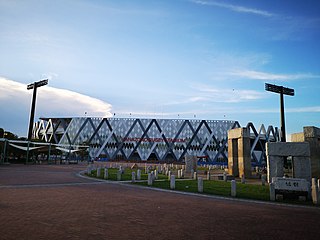
The Japan national rugby union team, also known as the Cherry Blossoms, Brave Blossoms, or simply Sakura, is traditionally the strongest rugby union power in Asia and has enjoyed and endured mixed results against non-Asian teams over the years. Rugby union in Japan is administered by the Japan Rugby Football Union (JRFU), which was founded in 1926. They compete annually in the Pacific Nations Cup and previously in the Asia Rugby Championship. They have also participated in every Rugby World Cup since the tournament began in 1987.

The Hanazono Rugby Stadium in Higashiosaka is the oldest rugby union stadium in Japan specifically dedicated to rugby. Its location is next to Hanazono Central Park. Owned by the City of Higashiosaka, it opened in 1929 with a capacity of 27,346. It is the stage for the annual National High School Rugby Tournament held every year at the end of December and has hosted important international, Top League games.

Tsuyoshi is a masculine Japanese given name.

Yoshikazu Fujita is a Japanese international rugby union player.
Katsufumi Miyamoto is a former Japanese rugby union player and coach. He played as flanker.
Kenichi Kimura is a former rugby union footballer who played for Japan. He played as a prop.
Yasuharu Kawase, is a former Japanese rugby union player. He played as flanker. A former Japanese international, former forwards coach of the Japanese national team and head coach for the Japanese U21 and U23 national teams. Kawase was also appointed as Japan selection coach, Japan A national team coach, head coach of the Japan students national team, as well as Kansai representative coach. Currently, he coaches Setsunan University RFC, which plays in the Kansai University Rugby Football Leagues' A League. He is also a teacher at Setsunan University.
Masami Horikoshi, is a former Japanese rugby union player and coach. He played as scrum-half. Currently he is the coach of Rissho University RFC.
Tatsuya Maeda is a former Japanese rugby union player who played as a fullback, as well as center and fly-half.
Koji Yasumi is a former Japanese rugby union player. He played as prop. Currently, he works for the non-profit organisation Heroes.
Shinji Onuki is a former Japanese rugby union player. He played as a wing
Akira Yoshida is a former Japanese rugby union player who played as centre.
Tomoya Haneda is a former Japanese rugby union player. He played as a lock.
Tsutomu Hirose is a former Japanese rugby union player. He played as a hooker.
Toshiro Yoshino is a former Japanese rugby union player. He played as a wing or as centre.
Naoto Nakamura is a Japanese former rugby union player who played as prop. He played 20 tests for the Japan national rugby union team including two matches in 1999 Rugby World Cup. Currently he is the scrum coach for Canon Eagles.
Takafumi Hirao, also known as Tsuyoshi Hirao, is a Japanese former rugby union player. He played as wing and as fullback. He is not related to the late Seiji Hirao. As of 2015 he works as teacher at Kobe Shinwa Women's University's Development and Education Faculty of Junior sports education Department, with "sports pedagogy", "kinematics" as field of specialization and "body and sports" and "sports education rooted in children's development" as research field.
Hideo Kaneshiro is a former rugby union footballer who played for Japan. Playing at flanker and as hooker, Kaneshiro played for Toyota Verblitz and had a cap for Japan against Argentina in Buenos Aires on 22 May 1993, being his only international test cap. He mostly played for Toyota Verblitz from 1991 - since he graduated from university - until his retirement in 2000.
Tsuji Takashi is a Japanese former rugby union player who played as scrum-half, he later became a coach, currently coaching NEC Green Rockets.
Yuto Fujita is a Japanese footballer who plays as a defender for J2 League club FC Osaka.



